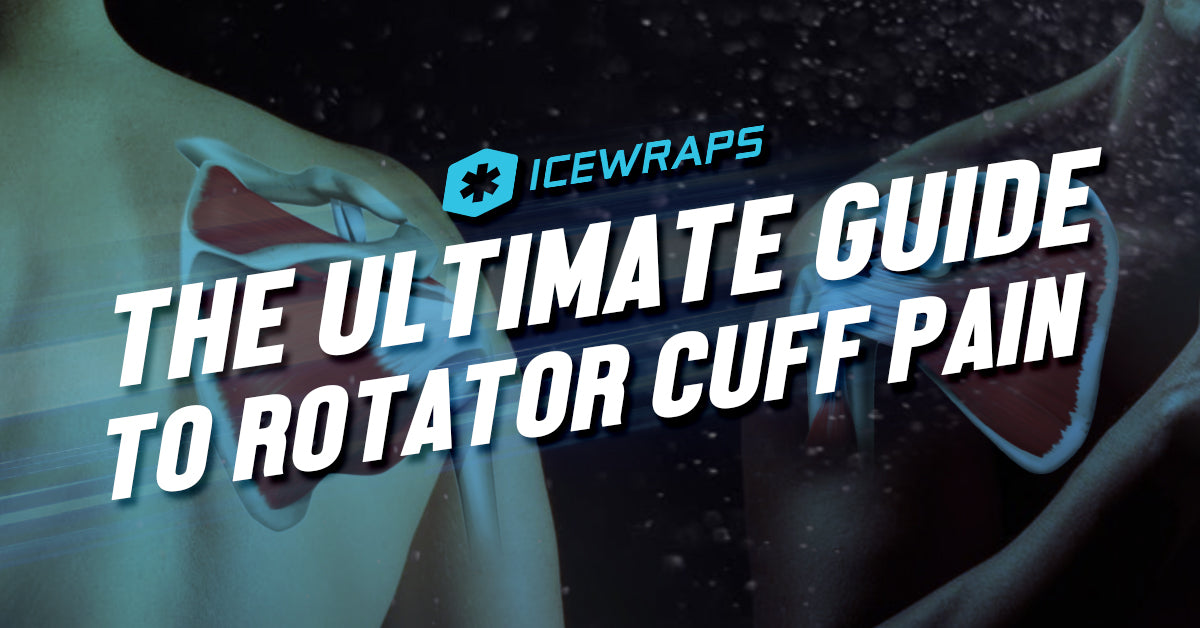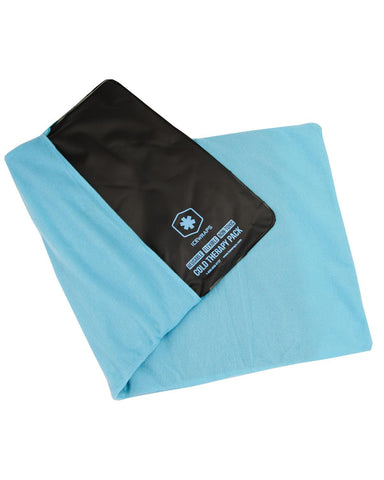Your Cart is Empty

Contents
Are your shoulders not working like they used to?
Before you dismiss your shoulder pain as a simple strain you can shake off, let’s run through a quick checklist:
Are you experiencing any of the following?
If you’ve answered yes to at least two of these questions, you might have injured your rotator cuff.
Rotator cuff conditions can affect anyone at any age, and it doesn’t matter whether you’re an athlete or not. One study showed that 22.1% of injuries to the locomotive organs (bones and muscles) are comprised of rotator cuff tears.
In this article, you will be learning about rotator cuff pain, its symptoms, causes, and treatments. But before that, let’s discuss briefly what the rotator cuff is and what it does.

Your rotator cuff is a group of muscles that allow you to raise and rotate your arms and shoulders. It is made up of 4 muscles which you can remember as ‘SITS’:
The supraspinatus muscle holds the humerus in place and is the muscle responsible for lifting your arm and giving it the support it needs to keep elevated.
The infraspinatus muscle assists in the rotation and extension of the shoulders.
The tres minor muscle assists shoulder abduction.
The subscapularis is the muscle responsible for holding the arms straight out and keeping it elevated. It also supports the upper arm with the shoulder blade.
These four muscles are held together and supported by tendons, which are basically thick bands of fibrous tissues. Whenever you feel pain in your rotator cuff, it’s likely caused by a torn or inflamed tendon or muscle.
If you want to learn more about the rotator cuff’s function and the role it plays as an integral part of your shoulders, you can check out this article here.
So you have pain in your shoulders, but you’re not sure whether it’s caused by your rotator cuff or not? Don’t worry - here are a couple of tests you can apply:
Injured rotator cuff muscles will always affect your shoulders’ range of motion because of pain, stiffness, and inflammation. It is the first apparent sign of a shoulder injury.
Here are a few muscle tests you can do to check your rotator cuff’s strength, stability, and range of motion.
Remember: If you can’t do these steps alone, you can have someone help you. If you have a broken bone, you can skip this step and wait until your fracture has healed.
Sometimes, your rotator cuff pain might not be caused by your muscles per se. Pain felt along the rotator cuff area can also be indicative of other conditions.
If there is any shoulder pain with neck pain, this may be caused by problems in the cervical spine. Shoulder pain with chest pains may signify heart conditions. Rotator cuff pain accompanied with pain along the shoulder blade can imply gallbladder and problems with the diaphragm.
If there is any possibility that your shoulder pain isn’t caused by your rotator cuff muscles, it is best to consult with your physician immediately.
For advanced cases such as calcification (calcium deposits that sit on your tendons and bones) or impingement, an ultrasound can be very helpful. If calcium deposits are situated on your bones, an x-ray may also be recommended by your physician.
Your rotator cuff pain can be caused by a lot of things. From casual muscle strains to tendinitis, here is a list of rotator cuff injuries from the most common to more advanced conditions.
Muscle fatigue is a condition characterized by a feeling of weakness or tiredness in your muscles. Essentially, muscle fatigue is a state of exhaustion of your rotator cuff.
It might feel like your muscles are gradually becoming weaker and weaker or you may notice a significant decrease in flexibility or capability to carry heavy objects.
Symptoms of muscle fatigue:
Muscle strains are often caused by overworking or overstretching. Lifting heavy objects can stretch your rotator cuff beyond its capacity, and exhausting your shoulders in overhead sports can cause an injury.
Symptoms ofmuscle strain:
Rotator cuff tears can be grouped into 4 categories: partial, acute, chronic, and degenerative.
Partial tears are when the muscles or tendons are partially torn. Partial tears can develop from abrupt and intense movements such as heavy lifting, or it can be caused by a sudden impact such as falling on your shoulders.
Acute tears on the other hand are tears where the muscles or tendons are completely torn.
Chronic tears are usually seen in athletes (baseball, basketball) or lifters - a lot of overhead athletes.
These excessive overhead activities overwork the rotator cuff muscles on a continuous basis, thus making these tears chronic. Chronic injuries may also be because of a previous injury which had permanently affected the shoulder’s anatomy and functions.
Chronic tears may lead to a degenerative tear, eventually worsening your condition and decreasing shoulder mobility and function.
Degenerative tears do not come around on their own. They’re usually caused by succeeding shoulder injuries, or an acute injury that has permanently affected the shoulder anatomy.
Repetitive stress is a huge factor in acquiring degenerative tears, but another factor is age. Ageing affects the blood supply in the rotator cuff. When blood supply is lessened, recovery becomes difficult as the body’s ability to repair itself is compromised.
Bone overgrowth or bone spurs is also another condition that can happen when you don’t attend to your rotator cuff injuries promptly. Bone spurs develop on the underside of the acromion process. This in turn, rubs against the rotator cuff tendon and causes shoulder impingement. Individuals over 40 years old are highly at risk for this.
Rotator cuff arthropathy is a rotator cuff tear with shoulder arthritis. It is an advanced form of shoulder arthritis, where the shoulder loses not just the cartilage that covers the joint surface, but also the tendons of the rotator cuff which keep it in place. This makes shoulder movement painful since the upper surface of the bones are unprotected when they are rubbed against the ligaments.
You might have heard of tendonitis (inflammation of the tendon), which we’ll discuss later on, but have you heard of tendinopathy? These two are often interchanged, but some studies have shown that tendinopathy actually causes tendonitis.
Tendinopathy is the breakdown of collagen in the tendon. Your tendons are fibrous structures which provide support to your muscles and connects muscles to bones. They are made up of collagen protein - a structural kind of protein that makes up ⅓ of all your body’s proteins. They’re a big deal.
Once this collagen protein breaks down, the integrity of your tendon structures are compromised, thus leading to tendon tears and inflammation.
Tendonitis is an inflammation of the tendons. While tendonitis can be caused by abrupt motions which in turn damage the tendon (such as falling or overstretching), most cases of tendonitis are caused by repetitive, strenuous activities such as overhead sports or job-related errands (painting, lifting, etc.)
Tendonitis can be easily addressed by conservative treatments such as using ice and compression, or taking non-steroidal anti-inflammatory drugs (NSAIDs.) Tendonitis left unattended can lead to more serious conditions like calcific tendinitis or frozen shoulders.
The treatment of rotator cuff injuries focuses on managing pain and restoring your muscles to its best possible function.
Conservative treatments for rotator cuff injuries include: rest, cold therapy, compression, elevation, taking non-steroidal inflammatory medications for pain management, and physical therapy.
For the first aid treatment of rotator cuff injuries, remember ‘PRICE’: Protect, Rest, Ice, Compression, and Elevate.
Protect - You might have heard of RICE (Rest, Ice, Compression, and Elevate) as a first aid treatment for most muscle injuries. PRICE is exactly the same, only with a little upgrade - Protect.
Protecting your muscles from further injuries might be common sense, but it’s something worth emphasizing.
Rest - Once you’re aware of your injury, don’t push yourself further. This might mean using support such as compression wraps to your rotator cuff. Steer clear from any strenuous activities while you’re recovering, and rest your shoulder as much as you can.
Ice - When swelling and inflammation occurs, apply an ice pack to deal with it. Cold therapy soothes the nerves and calms the swelling.
In case you’re experiencing muscle stiffness, tightness, or cramps, you can choose a hot therapy pack to warm the injury.
Whether you’re using a cold or warm therapy pack, make sure that the temperature is just right for your skin to prevent frostbite or burns.
IceWraps.com carries a wide variety of gel packs you can freeze or warm, as well as compression wraps which are custom-made to fit your shoulders. You can simply wear it and adjust it to your comfort, specifically addressing your rotator cuff pain.

|
 |
| ICEWRAPS EXTRA LARGE NECK ICE PACK WITH SOFT COVER | ICEWRAPS 12X21 OVERSIZE COLD THERAPY CLAY PACK WITH COVER |
 |
 |
Compress - For the first 24 to 48 hours of the rotator cuff injury, using elastic bandages or compression wraps to compress your strains can be helpful. Compressing your injured rotator cuff limits the swelling of the injury. But don’t make it too tight! We don’t want to aggravate the injury by cutting off the blood flow to the inflamed area.
Elevate - Elevating your shoulders above the heart minimizes swelling by moving fluids away. Do this along with the methods previously mentioned and the pain should be manageable within 72 hours.
If pain persists, taking non-steroidal inflammatory drugs (NSAIDs) is highly recommended. NSAIDs such as Ibuprofen (Advil, Motrin) or Naproxen (Aleve) can be helpful.
Corticosteroid injections are also beneficial for rotator cuff pain and frozen shoulders.
It is best to consult a physician when the pain continues, or gets worse, after applying these conservative treatments. You should also observe if your range of movement is getting back to normal. When movement becomes terribly limited and pain prevents you from performing daily routines, it is high time to schedule an appointment with your doctor.
Rotator cuff injuries, when not attended to immediately, can trigger further complications.
When the rotator cuff’s range of motion is limited due to inflammation or tears, they do not allow the humeral head to move smoothly. Impingement can happen since any changes to the structural make-up of the rotator cuff can make it difficult for the tendons navigate through the narrow bony spaces of the shoulders.
Any form of inflammation can cause fluid to accumulate in the joints, and the risks of calcification increases.
Age is also a very important factor in your rotator cuff’s rehabilitation. Those aged 40 and above may find it harder to recover from these injuries and must be given more attention.
Rotator cuff injuries are most common for older individuals, as well as those who are involved in overhead sports like swimming, baseball, tennis, etc.
If you live an active lifestyle, make sure to properly warm up before doing strenuous activities. If your muscles aren’t conditioned and stretched properly, they are prone to inflammation.
Strengthening exercises for your rotator cuff should use lower resistance and more repetitions. Strengthening exercises promotes a balanced strength in the shoulders. Here’s some you can do:
Injury to the rotator cuff can be a real pain, we know. With this little resource however, we’re hoping that you now know how to take care of your rotator cuff better.
Still not convinced that your shoulder pain is caused by your rotator cuff? You can check outthis article on other common shoulder injuries for more information.
Comments will be approved before showing up.